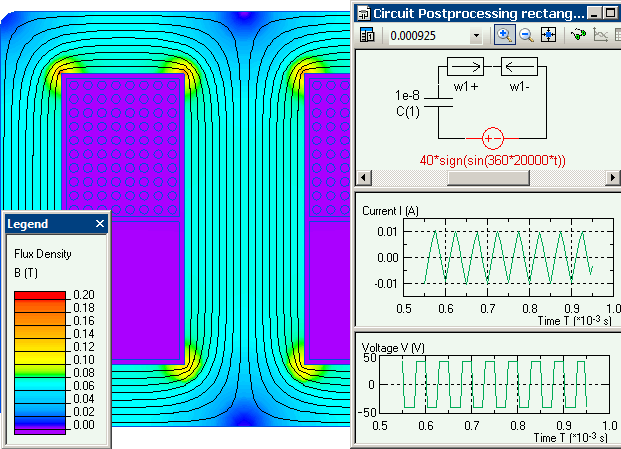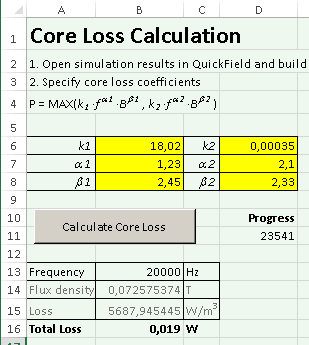Iron core loss in transient excitation mode
QuickField simulation example
This is an example of the iron losses calculation in transient magnetic simulation performed with QuickField software.
Problem Type
Plane-parallel problem of transient magnetics.
Geometry
Given
Core type: E19/8/5-3C81 [1]
Magnetic permeability of MnZn ferrite μ=2700
Primary winding:
Number of turns - 80
Waveform - periodic rectangular wave
Frequency - 20 kHz
Voltage magnitude - 40 V
Task
Calculate core loss.
Solution
According to [2] for rectangular waves it is possible to use Steinmetz-like equation (referred as equation (8) in this report):
Pv[W/m³] = max(k1·fα1·Bβ1, k2·fα2·Bβ2),
with material-dependent parameters, which for the E-core E19/8/5-3C81 from Ferroxcube are:
k1 = 18.02, α1 = 1.23, β1 = 2.45
k2 = 0.000350, α2 = 2.10, β2 = 2.33.
Following this approach, to estimate the losses at a square wave excitation, we need to run Transient Magnetic analysis with a square wave source, and at the moment when the fluxes are at their maximums integrate the volume losses across the parts of our interest.
This may be easily implemented using Microsoft Excel and QuickField.
Results
Magnetic flux density distribution at t = 2.5 ms (maximal values).

Total core loss is 19 mW.

References:
[1] Ferroxcube E19/8/5, E cores and accessories
[2] Testing Core Loss for Rectangular Waveforms, Phase II Final Report, 21 September 2011 by Charles R. Sullivan and John H.Harris; Thayer School of Engineering at Dartmouth.
- Video: Iron core loss in transient excitation mode. Watch on YouTube
- View simulation report in PDF
- Download simulation files (files may be viewed using any QuickField Edition).